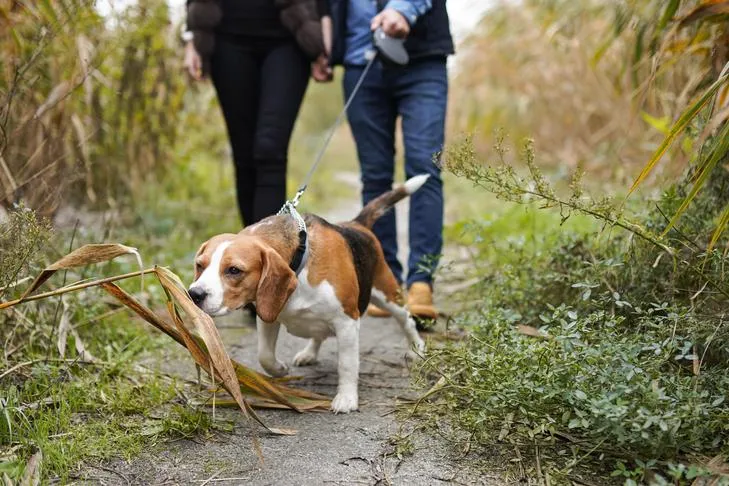Walking your dog should be an enjoyable experience for both of you, a time for bonding and exercise. However, for many dog owners, walks often turn into a frustrating tug-of-war, with their furry friend relentlessly pulling on the leash. Not only is being dragged down the street unpleasant, but it can also be unsafe, leading to injuries for both the dog and the owner, especially with larger breeds. Understanding how to stop dog from pulling on leash while walking is crucial for a harmonious relationship and safe outings.
Leash pulling is a common behavioral issue, but it’s one that can be corrected with consistent training and a few simple adjustments to your approach. Dogs naturally want to explore and move at their own pace, which often conflicts with our walking speed. The key is to teach your dog that a loose leash leads to good things, while pulling brings the walk to a halt. By implementing these 10 tips, you can transform your walks from a struggle into a leisurely and enjoyable activity, where you and your dog walk politely side-by-side.
1. Always Reward Good Leash Behavior
It’s easy to take good behavior for granted, but dogs thrive on positive reinforcement. They are more likely to repeat actions that earn them a reward, whether that’s a tasty treat, verbal praise, or the opportunity to sniff an interesting spot. If you only focus on correcting undesirable behavior and overlook polite walking, your dog might resort to less appropriate ways to get your attention or desired outcomes.
Whenever your dog walks calmly with a loose leash, be sure to reinforce that behavior. Carry treats with you on walks and be generous with praise and gentle pets. Let your dog know you appreciate their effort. In the initial stages of training, reward frequently and heavily. As your dog’s leash manners improve, you can gradually reduce the food rewards and substitute them with “life rewards,” such as a moment to explore a tree trunk or a brief greeting with another friendly dog.
2. Never Let Your Dog Walk When They Are Pulling
The primary reason your dog pulls is to get to where they want to go faster. If you allow them to continue moving forward while they are pulling, you are inadvertently rewarding the very behavior you want to discourage. This teaches them that pulling is an effective strategy to achieve their goals, making the problem worse over time. To stop a dog from pulling while walking, you must be firm and consistent with this rule.
The moment your dog applies tension to the leash, stop walking immediately. Plant your feet firmly and remain still. Do not move forward until the leash slackens. Your dog will eventually look back or turn to see why you’ve stopped. This brief pause is essential for them to associate pulling with the cessation of forward movement.
 Two Basenji dogs meeting each other in an outdoor field, one is on a leash.
Two Basenji dogs meeting each other in an outdoor field, one is on a leash.
3. Wait for a Loose Leash Before You Walk
After you’ve stopped because your dog pulled, the next step is knowing when to resume your walk. The answer is simple: wait for a loose leash. The leash should hang in a relaxed J-shape, and your dog should turn their attention back to you, even for a second. This might take a few moments initially, but your dog will eventually realize that pulling stops the fun.
When they offer that moment of slack and attention, praise them warmly and reward them with a treat held at your side. Then, calmly continue the walk. You might find yourself stopping and starting every few steps at first, especially with an enthusiastic puller. However, with repetition, your dog will quickly learn that a loose leash keeps the walk going, while tension brings it to a halt. This consistent consequence is vital for effective training.
4. Incorporate Life Rewards on Your Walk
Walks are more than just bathroom breaks; they should be enriching experiences that provide both physical exercise and mental stimulation for your dog. While you’re in the midst of training, it can sometimes feel like your dog isn’t getting to enjoy these benefits fully. Integrating “life rewards” can significantly enhance your training and your dog’s overall enjoyment of the walk.
Life rewards are everyday things your dog loves, such as the chance to investigate a particular shrub, greet a friendly person, or have a brief play session. For instance, if your dog walks politely for a set distance without pulling, you can “release” them with a verbal cue to sniff freely for a few minutes. These bonus rewards reinforce the idea that good behavior truly pays off and makes them more likely to train your dog to not pull on leash.
5. Walk at a Good Pace
Often, humans walk at a much slower pace than dogs naturally prefer. Even small toy breeds can have a quicker gait than you might expect, and larger dogs certainly possess the energy to move at a brisk clip. This difference in desired speed is a significant reason why dogs pull – they want to get going and explore!
To help your dog feel more engaged and less inclined to pull, try to choose a walking pace that is comfortable and stimulating for both of you. While you can certainly teach your dog to match your speed, during the initial training phase, a slightly quicker pace can make it easier for them to learn not to pull. A more dynamic walk can capture their attention and reduce their urge to forge ahead.
6. Be Consistent With Your No-Pulling Rule
Consistency is paramount in dog training. It can be incredibly tempting to let your dog pull when you’re in a rush, perhaps running late for work, or if the weather is unpleasant and you just want to get the potty break over with. However, every time you allow your dog to pull, you are effectively undermining all the training you’ve done.
Any instance where you permit pulling will set your training back to square one, reinforcing the unwanted behavior. You must be unwavering with your no-pulling rule, regardless of the circumstances. Until your dog reliably walks with a loose leash, even for short distances, it’s better to manage their bathroom needs in a controlled environment like your yard or a nearby curb, saving dedicated walks for when you have ample time to commit to training.
 A curious Beagle dog pulling on its leash to sniff the ground during an outdoor walk.
A curious Beagle dog pulling on its leash to sniff the ground during an outdoor walk.
7. Keep Training Sessions Short and Fun
Working with a persistent leash puller can be frustrating and even disheartening, especially when initial progress is slow. You might find yourselves barely making it to the end of your driveway. Instead of pushing your dog (and yourself) until both of you are feeling cranky and demotivated, aim to keep your training sessions short, upbeat, and positive.
Puppies, in particular, have very short attention spans, and asking for too much too soon will likely lead to negative results. Remember, the goal isn’t to cover a certain distance; it’s to achieve a loose leash walk, even if that’s just to the next mailbox or a few houses down the street. Ending on a high note, even after a short successful period, will build your dog’s confidence and eagerness for the next session, making it easier to learn how to stop your dog from pulling on a walk.
8. Be Interesting and Engaging on Walks
The outside world is a sensory wonderland for dogs, brimming with novel sights, sounds, and most importantly, smells. These myriad distractions constantly compete for your dog’s attention, making them eager to pull you towards the next fascinating discovery. If you’re absorbed in your phone or simply passively walking, your dog has little incentive to focus on you.
To counteract these external temptations, you need to become the most interesting and engaging thing on the walk. Talk to your dog, offer unexpected quick training breaks, or initiate a brief game. By being an active participant in the walk, your dog will be more likely to pay attention to your cues and follow your lead, eagerly anticipating what exciting thing you’ll do next.
9. Stay Calm
 A calm Cavalier King Charles Spaniel walking on a lead outdoors in a park setting.
A calm Cavalier King Charles Spaniel walking on a lead outdoors in a park setting.
Walks can present a variety of emotional situations, from spotting a favorite neighbor to encountering a barking dog or something perceived as frightening. It’s crucial for you to manage your own emotions, whether you feel excited or stressed. Dogs are incredibly perceptive and skilled at reading human emotions; your mood can travel down the leash, impacting your dog and potentially intensifying their excitement or anxiety.
To help your dog remain calm and focused, you must stay calm yourself. Projecting a relaxed demeanor shows your dog that there’s nothing to be overly excited or worried about. The more relaxed your dog is, the more likely they will be able to listen to your commands and behave appropriately, making the training process smoother and more effective.
10. Engage Your Dog In Distracting Situations
When faced with powerful distractions like other dogs, squirrels, or even unfamiliar people, it’s common for dogs to forget their leash manners and revert to pulling. Some dogs might pull to get closer to what excites them, while others might pull to retreat from something they find suspicious or intimidating. In either scenario, polite leash behavior often goes out the window.
To help your dog cope with distractions, proactively shift their focus back to you. Before they become overly fixated on a distraction, calmly offer them treats or initiate a simple training game. Ask for a “sit,” a “hand target,” or practice the “watch me” cue to establish eye contact. These exercises are easy for your dog to perform and will keep them engaged with you as the distraction passes. Being proactive and capturing their attention before they notice the distraction is key to maintaining control and teaching them to disregard external stimuli.
Mastering how to stop your dog from pulling on walks requires patience, consistency, and understanding of canine behavior. By implementing these 10 effective strategies, you can transform your walks into enjoyable outings where you and your canine companion move in harmony. If you continue to struggle, consider seeking advice from a certified professional dog trainer who can offer personalized guidance.
